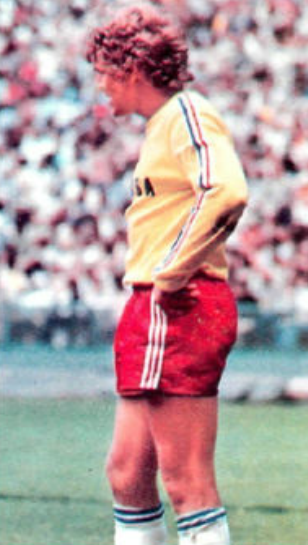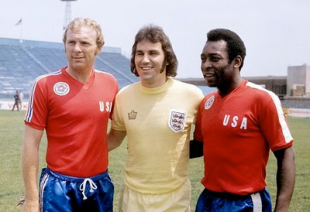Featured image: Bobby Moore, Gerry Francis and Pele before the Team America vs. England game at JFK
The 2012 MLS All-Star Game is the first time Philadelphia has hosted a major pro sport All-Star event since the NBA came to town in 2002. The last time the city was host to a pro soccer all-star game was in 1976 when the North American Soccer League’s Team America faced England at JFK Stadium as part of the Bicentennial Cup.
A brief look at past all-star games in Philly
Philadelphia soccer history contains many examples of local all-star teams facing international teams. As early as 1909, a picked team of players from the city’s Associated Cricket Club’s League played the touring Pilgrims club from England, as did an All-Philadelphia team a few days later. While the two teams lost by a collective score of 12–0, in between those two matches Philadelphia Hibernian redeemed the city’s sporting honor by handing the Pilgrims their first loss of the tour. Before the Second World War, picked teams would play—and lose—to Corinthian FC in 1924, Maccabi FC in 1927, a team of Italian all-stars called Palestra Italia FC in 1928, Celtic in 1931, Charlton Athletic in 1937.
Visits after the war from the likes of Liverpool (1946), Inter Milan and the Scottish national team (1949), Hamburg and Besiktas (1950), Celtic (1951), Manchester United (1952), Nuernberg (1955), and Manchester City (1958) saw the familiar pattern of all-star teams made up of players from local American Soccer League clubs being thrown together with little preparation to be slaughtered by foreign visitors.
Team America
Things were looking up for the NASL in 1976 which, after early struggles to expand the league, now stood at 20 teams. Pele had joined the league in 1975 and international stars such as George Best, Giorgio Chinaglia, Rodney Marsh, and Bobby Moore had followed. To honor the country’s bicentennial—and also grow soccer’s expanding profile in the US—the US Soccer Federation organized the Bicentennial Cup. Three-time World Cup winner Brazil, two-time World Cup winner Italy, and one-time World Cup winner England were invited to participate in a round-robin six-city coast-to-coast tournament that would include an “American” team. But it would not be the US national team. Rather, they would be playing against Team America, made up of NASL all-stars. Coached by the English manager of the New York Cosmos, the roster seems to have been weighted with players from that team. More importantly, of the 13 Americans invited to tryout for the team, only six made the 20-player roster.
The New York Times would write on May 17, 1976, “Imagine a trio of Georgie Best, Giorgio Chinaglia and Pele. No country in the world has three guys like that to play forward.” The strange spectacle of seeing World Cup greats like England’s Bobby Moore and Brazil’s Pele wearing shirts with “USA” on their chests aside, while US Soccer saw Team America and the tournament as as an opportunity promote soccer in America, others saw the makeup of the team as a lost opportunity.
Hubert Vogelsinger, the German-born manager of the Boston Minutemen, told the St. Petersburg Times on May 22, “We’re making this series an ethnic affair, putting in these foreign players. Now we’re gonna lose 2–1 or 3–2 instead of 5–1 or 4–0. What are we going to prove? That Pele and George Best and Rodney Marsh know how to play soccer? We already know that.” He added, “This was unbelievable shortsightedness. Here we could have gained international recognition by exposing our American team to these others. Even if we lose 10–0, so what? We are an arriving nation in this sport and we can only get better. The experience would have been invaluable.”
Rodney Marsh agreed. “Naw, I’m not going to go. This should be for the Americans. We (foreign stars) shouldn’t be on the team. Let the Americans play.” George Best joined him in withdrawing from the team and Pele made it clear that he would not play against Brazil.
Against Italy and Brazil
On May 23, the day of Team America’s first match of the tournament against Italy, the New York Times wrote, “Team America has been called Team Imports, Melting Pot, and a bunch of foreigners playing for America.” In front of 33,455 spectators at RFK Stadium, Italy trounced Team America 4—0. The match report in the May 24 edition of the New York Times concluded, “the Americans proved that a group of international superstars has trouble playing together as a team with so little preparation. The picture presented by America was not a pretty one.” Bobby Moore said after the game, “Very inexperienced. You cannot put a team together like that in two days.”
Five days later, Team America faced Brazil in front of 20,253 spectators at Seattle’s Kingdome. Bob Rigby, the Ridley Park-born goalkeeper who had led the Philadelphia Atoms to the 1973 NASL championship and had recently joined the New York Cosmos along with former Philadelphia Atom and Trenton-born Bobby Smith, had had a nightmare game against Italy. His frustration was evident when he spoke to Sports Illustrated after learning he would be benched for the match against Brazil.
“We never have any time together. They never give us any preparation. And we’ve had less background than anybody. I’ve played five months a year for the last three years. Didn’t even play professional ball until I came out of college. What we need is as much exposure to good players and coaching as we can get. Our game really needs it…As long as people come over here they’re going to be dictating to us. We have this rule that there’s six American citizens on a side and that’s the only protection we have. Push the number up? They say so, they say so. Every team has six American players—on the bench.”
While the Pele-less Team America played better than they had against Italy, they still fell short, losing to Brazil 2–0.
Against England at JFK
While Team America was being trounced by Italy, England lost a close 1–0 game to Brazil at LA Memorial Coliseum. Down 2–0 to Italy in the first half in front of 40,650 spectators at Yankee Stadium, England fought back to win 3–2. This left them behind Brazil and tied with Italy in the tournament standings going into their final game against Team America on May 31 at JFK Stadium. While second half substitute and Scottish winger Stewart Scullion scored a late goal for Team America for their lone goal of the tournament, it was not enough. England won 3–1 with Kevin Keegan netting two of the goals. Only 16,231 spectators showed up for the game.
At the Yale Bowl later that day, Brazil topped Italy 4–1 to take the Bicentennial Cup championship and England finished in second.
Legacy
NASL commissioner Phil Woosnam said in the May 23 edition of the New York Times lead-up to the tournament, “The sport has reached the point now where we can realistically think in terms of becoming a major power. It won’t happen overnight, but it will happen in the next decade. I will say right now that in ten years soccer will be bigger than football. And in rare moments, I say five years.” Eight years after those comments, the NASL folded.
In 1983, the NASL fielded another Team America, and this team was a professionalized version of the USMNT. The league was already struggling and the new Team America was intended to both bolster the league as well as strengthen the fan base for the national team and feed players into the national team system. Two players from the original Team America—Juli Veee (a naturalized US citizen born in Hungary) and Arnie Mausser—featured on the team, but several high profile players refused to leave their current clubs. In the end, the team finished last in the league and folded after the 1983 season.
While the NASL may have failed to fulfill its promise, US Soccer was beginning the slow process of getting its act together, a process that included the professionalization of the federation’s organizational structure, providing salaries for national players who were not contracted to professional clubs abroad in the absence of a professional league in the US, hosting the 1994 World Cup, and an unbroken string of World Cup appearances by the USMNT team beginning in 1990. While it would be foolish to say that US Soccer will be a major power on the world stage in ten years, let alone five, that reality is closer now than when the Bicentennial Cup was played 36 years ago.
MLS has learned the lessons of the collapse of the NASL well and the Philadelphia Union, and its home at PPL Park, are but one example of this. Whether the MLS All-Star team, no doubt with short preparation, this July follows in the footstep of losses that mark the history of such games in Philadelphia is beside the point. Now, the All-Star game is about celebrating the continued success of the league, while simultaneously marketing that success to an already crowded American sport landscape. A radically different media landscape exists now compared to that which existed in the days of the NASL and the sophisticated American soccer fan cares less about the game being “bigger than football” than that efforts to develop the talent pool of American players and grow the American soccer fan-base continue in a positive direction. Ultimately, the success of both MLS—and US Soccer—will go hand in in.
Footage of Team America vs. England at JFK
This article was originally published on January 25, 2012.




The Pilgrims as in Darlington FC? Too bad they might go out of business.
No, different Pilgrims. This was a team largely made up of gentleman amateurs whose purpose was to show we scraggly Americans how soccer is supposed to be played. (Click on the link in the article for more info.)Their tours (they did two), along with tours by Corinthians (another amateur team), helped to boost the popularity of local leagues all around the East Coast and as far west as Chicago and St. Louis. Agreed about Darlington, though.
Wonderful article Mr. Farnsworth, thank you. I was at the JFK match against the 3 Lions. However I was only 6. I don’t really have any clear recollection of the experience other then just feeling overwhelmed by the expanse of JFK.
Thanks, Jon (please call me Ed) – I was 9 at the time but missed it! I also miss JFK.
Or Professor Farnsworth. PhD in Soccer History.
GOOD NEWS EVERYONE!
Everyone else can call me Ed but I do prefer Professor Farnsworth from you.
Im thankful for the post. Cool.
is that rigby in net i think it was he was always #1 for the us
He was from about 1973 to 75, with the Bicentennial Cup his last hurrah. He was soon replaced by Arnie Mausser who had a great 1976 with Tampa Bay, and who manned the nets pretty regularly after that.
Did Rigby constantly call the players on his own team by the wrong name back then too?
I Was at that game at JFK with my father.